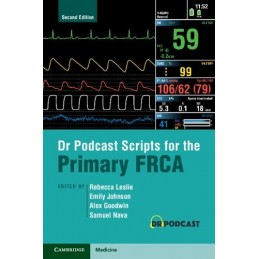Description
Widely popular amongst exam candidates, Dr Podcast Scripts is a great way to revise for your Primary FRCA. Providing questions and model answers spanning the breadth of the exam syllabus and fully updated in this second edition, this revision aid allows you to experience the format of questions likely to be asked and it provides tips on how to excel in the exam. Supplemented with helpful illustrations to explain answers, you will learn what to expect in the exam and how differently worded questions on the same topic require modified approaches. Written and updated by successful candidates providing insight and experience of the exam, all the material has been reviewed by experienced consultants with detailed knowledge of the educational standards. If you are preparing for your Primary FRCA exam, Dr Podcast Scripts for the Primary FRCA is a must!
Product Details
Reference
103287
EAN13
9781009016322
ISBN
9781009016322
Data sheet
Publication date
2025
Issue number
2
Cover
paperback
Pages count
450
Dimensions (mm)
154.00 x 233.00
Weight (g)
680
1. Physiology: 1.1 Respiratory physiology; 1.1.1 Lung volumes and control of breathing; 1.1.2 Respiratory compliance and surface tension; 1.1.3 Ventilation, perfusion and dead-space; 1.1.4 Alveolar gas equation and shunt; 1.1.5 Pulmonary blood pressure and hypoxic pulmonary vasoconstriction; 1.1.6 Oxyhaemoglobin dissociation; 1.1.7 Altitude physiology; 1.2 Cardiovascular physiology; 1.2.1 Cardiac cycle; 1.2.2 Coronary circulation; 1.2.3 Pacemaker cells; 1.2.4 Valsalva manoeuvre; 1.2.5 Exercise physiology; 1.3 Physiology of the central, peripheral and autonomic nervous systems; 1.3.1 Cerebral circulation; 1.3.2 CSF; 1.3.3 Blood-brain barrier; 1.3.4 Action potentials; 1.3.5 Spinal cord; 1.3.6 Reflex arc; 1.3.7 The autonomic nervous system and adrenoceptors; 1.4 Physiology of the neuromuscular junction; 1.4.1 Neuromuscular junction; 1.4.2 Muscle physiology; 1.4.3 Pain pathways; 1.5 Fluids and renal physiology; 1.5.1 Fluid balance; 1.5.2 Acid-base physiology; 1.5.3 Renal physiology; 1.6 Liver and endocrine physiology; 1.6.1 Glucose and metabolism; 1.6.2 Pituitary and endocrine function; 1.6.3 Thyroid; 1.6.4 Adrenals; 1.6.5 Starvation and the stress response; 1.6.6 The liver and clotting; 1.6.7 Proteins and haemoglobin; 1.7 Immunology; 1.7.1 Immunology; 1.8 Pregnancy; 1.8.1 Physiological changes in pregnancy; 1.8.2 Maternal-fetal circulation; 2. Pharmacology: 2.1 Pharmacological principles; 2.1.1 Pharmacokinetics; 2.1.2 Pharmacodynamics; 2.1.3 Drug interactions; 2.1.4 Agonists and antagonists; 2.1.5 Isomerism; 2.1.6 Pharmacogenetics; 2.2 Intra-venous anaesthetic agents; 2.2.1 Propofol and thiopentone; 2.2.2 Ketamine and etomidate; 2.2.3 Rapid Sequence Induction; 2.3 Inhalational anaesthetic agents; 2.3.1 Inhalational agents; 2.3.2 MAC; 2.3.3 Nitrous oxide; 2.4 Neuromuscular blocking agents and anti-cholinesterase; 2.4.1 Neuromuscular blocking drugs; 2.4.2 Suxamethonium; 2.4.3 Anti-cholinesterases; 2.5 Local anaesthetics; 2.5.1 Local anaesthetics; 2.6 Analgesia agents; 2.6.1 Analgesic agents Dana L Kelly; 2.7 Drugs acting on the nervous system; 2.7.1 Anti-convulsants; 2.7.2 Benzodiazepines; 2.8 Drugs acting on the cardiovascular system; 2.8.1 Anti-hypertensive agents Caroline V Sampson and Samuel Nava; 2.8.2 Anti-arrhythmics; 2.8.3 Inotropes; 2.9 Drugs acting on the gastrointestinal tract; 2.9.1 Drugs acting on the GI tract; 2.9.2 Anti-emetics; 2.9.3 Hypoglycaemics; 2.10 Antibiotics; 2.10.1 Antibiotics; 2.11 Anti-coagulants; 2.11.1 Anti-coagulants; 2.12 Statistics; 2.12.1 Statistical data; 2.12.2 Statistical analysis; 2.13 Drugs used in major haemorrhage; 2.13.1 Tranexamic acid and drugs used in major haemorrhage; 3. Physics: 3.1 SI units; 3.1.1 SI units; 3.2 Biological signals and their measurement; 3.2.1 Biological signals; 3.2.2 Electrocardiogram; 3.2.3 Neuromuscular monitoring; 3.3 Gas flow and its measurement; 3.3.1 Gas laws; 3.3.2 Flow; 3.3.3 Measurement of gas volume and flow; 3.4 Gas supply and delivery; 3.4.1 Cylinders and gas supply; 3.4.2 Breathing systems; 3.4.3 Vaporisers Rebecca; 3.4.4 Soda lime and carbon dioxide absorption; 3.4.5 Scavenging systems; 3.5 Measurement of oxygen, carbon dioxide and anaesthetic agents; 3.5.1 Measurement of anaesthetic agents; 3.5.2 Oxygen measurement; 3.5.3 Pulse oximetry; 3.5.4 pH and CO2 measurement; 3.5.5 Capnography; 3.6 Temperature and humidity; 3.6.1 Heat loss; 3.6.2 Temperature and its measurement; 3.6.3 Humidification; 3.7 Pressure and cardiac output measurement; 3.7.1 Pressure measurement; 3.7.2 Blood pressure measurement; 3.7.3 Resonance and damping; 3.7.4 Intra-cranial pressure measurement; 3.7.5 Cardiac output measurement; 3.8 Electricity; 3.8.1 Electricity; 3.8.2 Electrical safety; 3.9 Equipment; 3.9.1 Defibrillators; 3.9.2 Lasers and diathermy; 3.9.3 Ultrasound.




 Delivery policy
Delivery policy
 Security policy
Security policy
 Return policy
Return policy
